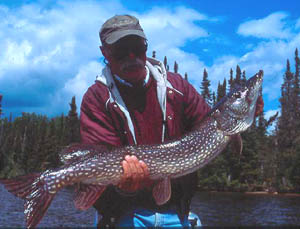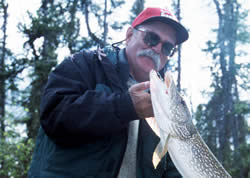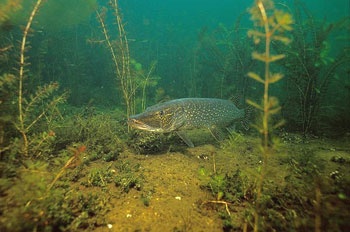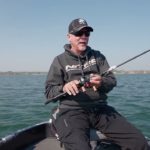Are Spoons Really the Best Pike Lures?

Fathers and sons are expected to have disagreements. In the last 15 years, since my son’s first fly-in trip, the most enduring disagreement Craig and I have had concerns which color spoon is most productive for pike. Understand, however, that we both chuck spoons as a lure of choice when fishing for pike.
Our difference of opinion began when I first showed Craig how effective spoons were in catching pike that really did not want to be caught. As true with many other “tricks” I showed him, he has now outstripped me in skill. Perhaps I should simply adopt his preference for a red-and-white and give up the 5-of-diamonds.
The nature of spoons
A stop at any tackle shop in pike country will reveal the wide variety of spoons available. For someone outfitting a tackle box, the rub is they all work.
Basically, spoons are hammered or stamped pieces of metal, concave on one side and convex on the other. This shape causes the spoon to wobble side-to-side. During retrieve, the concave side rides up and the concave down.
Most spoons are narrow toward the leading end and wide at the trailing end. Narrow spoons, like most of Len Thompson’s spoons, Johnson Silver Minnow and Rapala spoons, wobble on a tight axis, and wider spoons, like Dardevles and Blue Fox spoons, wobble on a wider axis. An oblong spoon, like a Red Eye, wobbles on an even wider axis.
Each angler has to choose among the styles. Yet, in my experience, the tighter wobble is most productive when pike are aggressive and the wider wobble when pike are neutral.
While spoons are made of metal and sink rapidly when not retrieved, during normal retrieve water pressure on the underside of a spoon causes it to rise in the water column. Water works on spoons just as air pressure on the bottom of a shaped airplane wing lifts the plane. At a steady, moderate-paced retrieve most spoons will run a couple of feet deep. To get more depth, slow down or pause from time-to-time. Generally, narrow spoons will run a little deeper than comparable weight wide spoons as the narrow spoons have less surface.
Spoons are stamped of metals of different thickness. Of the spoons I carry, Blue Fox spoons are thickest and Len Thompson the thinnest. Other things being equal, thicker spoons run a little deeper than thinner ones.
Spoons come in a variety of sizes. Some are small enough for trout in streams. Others weigh several ounces and are 6 or more inches long. For pike, the optimum sizes range from 3/4 ounce toward a couple of ounces and from 3 to 5 inches. Smaller ones are likely to catch hammer handles only and the larger ones are hard to cast. If the wind catches the concave side of a big spoon, chances are the cast will land in the woods. Larger spoons, of course, are suitable for trolling, and I carry half a dozen or so in my pike box.
Johnson Silver Minnows have a single wire weed guard. When I was a boy, Johnson’s Silver Minnow was a favorite pike bait. I did not have a driver’s license, but Mom and Dad let me walk down to the lake near the cabin and take the boat. With a pork rind trailer, I chucked the Silver Minnow into the lily pads and cabbage. While I did not catch any trophies, I caught lots of pike. It was the start of a long and productive relationship. At the end of the day, Mom let me store my spoon and pork rind in a cup of water, to keep the pork rind moist, on the dinner table.
Most spoons come with treble hooks. Given the places I like to fish, treble hooks are more often a nuisance than insurance that a big fish will not be lost. I usually replace trebles with quality single hooks. Trailer hooks used by bass anglers on spinnerbaits are just the ticket. Be sure that the eye of the replacement hook is large enough that the hook swings freely. Another advantage of a single hook is that when you reach for a big pike, and it thrashes around, multiple pieces of sharp metal do not head for your vital spots.
If the spoon does not support the hook with a stout split ring, replace the split ring.

Why spoons work:
Spoons combine sound and vision to attract pike.
As they wobble, spoons displace water. Pike are very sensitive to vibrations caused by moving things in the water through lateral line reception. Research among laboratory muskies indicates that lateral line reception is particularly important in locating things far away, things like a struggling minnow or a trolling motor. Wobbling spoons create what I can best describe as “thumps” as they move through the water. Doing so, they alert pike from a distance that something is moving. Obviously, narrow spoons create less, but more rapid, thump than wider spoons.
Pike also see spoons. An overlooked element of the visual appeal of spoons, I believe, is reflection off the lake or river surface. Particularly on a calm day when the surface, from below, functions as a mirror, the light captured by the concave surface is reflected from the spoon to the surface and then back into the water. As the spoon wobbles, the light reflected from the surface comes and goes. From the perspective of a pike, even one many feet away, the reflected light must appear as a strobe.
Often I am asked if the color on the concave side of a spoon “makes a difference.” You bet it does. Many years ago, fishing the lakes of Michigan’s Upper Peninsula for pike, I learned that color on the concave side of a spoon had an impact on spoon effectiveness. Nickel works best in clear lakes and rivers, and copper, brass or some other dark color works best in the tannin-stained lakes so common in pike country. Fishing where there are fish is more important than the color of the concave side, but given my druthers I follow the rule above.
My pike box is filled with a rainbow of spoons. Virtually every color is represented, some that I do not even have a word to describe. And, over the years, I have caught pike on many of the colors.
Truth is, however, that only three colors get much serious use. If pike are hitting everything, I chuck whatever happens to be on top of the pile. When things get a little tougher, I stick with the 5-of-diamonds, red-and-white, and chartreuse firetiger.
Five or six years ago, Craig and I pushed our way back to Bartley Lake, about 60 miles north of Fort Francis, Ontario, a lake with a reputation for big pike. Once the snow stopped on that early June morning, we began to catch pike. No trophies, but plenty in the 7-pound to 12-pound class. And we renewed our debate. Craig would catch a couple on his red-and-white. While he was extolling the virtues of his skill and lure choice, I would catch a couple on a five-of-diamonds. Though I would not have admitted it at the time, either worked great.

Presentation
Presentation, depth and speed, are probably more important than color.
Spoons, as indicated above, tend to rise in the water column when moving. Heavy sinkers or slow retrieves can cause spoons to run deeper.
Spoons work in all the likely pike spots. Think of spoons as search baits. While spoons work well at slow speeds, they also are a means to strain water. Near fallen trees, rocky shoals, long points, and shallow bays are all good spoon targets. With a single hook, cabbage patches and other weeds can also be fished with spoons.
Over the years, the most effective retrieve has been a steady retrieve at a speed that permits me to feel the spoon wobble. A couple of times in each retrieve, stop the spoon and let it fall. Sometimes a paused spoon will actually back up. If a pike is following, it will almost always grab a spoon backing up towards it.
Letting a spoon drop causes it to flutter, side-to-side, as it falls. On rocky banks or shoals, where the bottom shelves and water gets deeper, are ideal spots to flutter a spoon. Along the edges of weeds or fallen trees are also prime flutter locations.
Pike follow spoons (and other lures, too) right to the boat, sometimes making a last second surge in an effort to catch whatever they think is about to escape. When I was a kid, I found this pike practice exceedingly frustrating. With spoons, trailing pike can often be teased into striking.
A change of retrieve direction, when a spoon is 25 or 30 feet from the boat is often the trigger for a strike. I learned this trick from Dad, many years ago. Dad changes the direction of his retrieve by swinging his rod tip from right to left so easily I do not think he even realizes he is doing it.
Half a dozen years ago Craig and I caught pike-after-pike at Suzanette Lake in Ontario’s Quetico Park with a jigging motion when fish followed to the canoe. If we saw a pike, and the pike would not take a paused spoon, we began jigging the spoons up and down next to the canoe. Do not give up too soon. A pike that has dropped out of sight may still be hanging around, ready to snatch your spoon. Leave about 8 or 10 feet of line between your rod tip and the spoon. Too close and when a nice pike strikes it may jerk your rod out of your hand or snap the line. As we caught pike, we renewed the debate over the effectiveness of our favorite colors.
Several years ago I did a short piece suggesting this jigging technique. A reader wrote that this method led to too many pike being hooked deeply. I kept track of the next 100 pike I caught on spoons and I did not find any significant difference in deeply hooked fish, whether hooked during a normal retrieve or at boat-side jigging. My reader may be correct, but I could not verify his fears.
Spoons are also excellent lures to toss at a pike that follows some other lure to the boat, then swims away. Keep one rig with a spoon handy. As a trailing pike turns away, grab the rod with the spoon and cast ahead of the disappearing pike. And hang on!
Gear
For spoon feeding pike, I use the gear I use for other lures. Generally, I fish bait casting tackle. I use a 6 & 1/2 or 7 foot rod. My preference is for a rod with a pretty fast tip because I like to feel the spoon wobble. But my rod has a pretty stout shaft below the tip.
Lighter line is more sensitive to the spoon’s wobble than heavier line. Rather than 50 pound test, then, I usually wind 20 pound test monofilament on my spoon reel. In the last couple of years I have used Spectraâ fiber line occasionally for spoons and I like it. My Spectraâ fiber line is 60 pound test with 14 pound monofilament diameter. Braided line, for me at least, does not cast as well as monofilament, but I’ll get used to it.
This past year, I used 12 inch, 80 pound test fluorocarbon leaders for all my pike fishing. While I still carried a variety of wire leaders (and probably will out of tradition for many years to come), I liked the fluorocarbon leaders.
The battle rages
Are spoons really the best pike lures? Probably there is no single best lure for any species. Lures are tools. Spoons work most effectively for pike when they are active, yet not overly aggressive. Pike can be caught, but you have to work for them.
While I was working on this article, I emailed Craig on another matter and told him what I was doing. He responded, “Have I not given you enough evidence to get off your 5-of-diamonds kick? If you keep writing articles that claim your 5-of-diamonds is better than my red-and-white, your credibility in the outdoor world may start to suffer!”
Can you beat that? Drag a kid all over North America fishing, and that’s the thanks you get! Next he’ll blame me for the collapse of western civilization.





